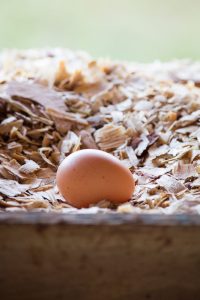The long, warm days of summer are coming to a swift end. Just as quickly, you may have noticed a sudden drop in your flock’s egg production!
Chickens will slow down laying during the fall for two reasons; less sunlight and the molt.
In the world of chickens, less daylight equals less prolactin.
Prolactin exists in most creatures and is a reproductive regulating hormone. Prolactin is responsible for stimulating the ovulation cycle in a hen. No one really knows why, but in our domestic chickens, prolactin levels decrease when days begin to have less than 12 hours of sunlight.
Without a normal ovulation cycle, hens slow, or even cease laying eggs.

Autumn days are over quick, and winter days even faster!
With less daylight to trigger prolactin, hens slow down their laying.
Another reason for egg production slowing can be due to the annual feather molt. Chickens lose their old feathers every year at this time and begin to grow a new set. Molting takes a great deal of energy and protein from the bird. Hens generally will almost stop laying during this time due to the energy demand on their little bodies.
One way to keep egg production up is to add a light to the coop.
There are many options for the backyard flock owner when it comes to lighting. There are even solar options available, with less dangling wires to threaten a coop accidentally igniting. Multiple light studies have been done in industrial sized laying hen houses. One study was even conducted on different colored lights and the various effects on egg production.
For a small, home flock, adding a light in the coop will keep egg production up in late autumn/winter, after the molt. Try adding extra light for a few hours early in the morning, instead of at night. That way, you ensure the chickens can see their way up to the roost with whatever daylight is naturally left. Keeping a light on at night, then shutting it off can be quite unexpected to your chickens. Leaving them confused and unable to see where to safely hop up onto the roost. For this reason, it is recommended instead to add hours of artificial light in the morning.
Try for at least 12 hours total of light, but not exceeding 16 hours.
(Be aware that having a light for your hens, and then abruptly not using one can confuse their natural hormones and send them into another molt in the dead of winter.)
Just be consistent, and if you sue a light, keep using it for the recommended hours daily until spring arrives.

You can also help your hens lay more in the colder months by supplementing their diet. Cold weather means less green grass and bugs to forage on if you let your birds free range. You can add some extra nutrients by mixing sunflower seeds and whole corn. Most feed stores sell a scratch grain, which is essentially a mix of pelleted chicken feed and multiple grains. Mix this in with your normal pellet or crumble for added nutrition. Of course, keep giving your flock table scraps during the colder months as well!
Experiencing a drop in egg production during cold months can be disappointing. With a little extra help, your hens may still give you a few eggs. Rest assured it isn’t your fault; just a normal part of a chicken’s yearly cycle! Spring will be right around the corner before you know it, and you will be back to having more eggs than you can eat!